Philip Morsberger: A Passion for Painting
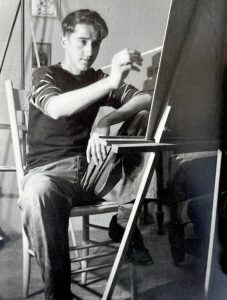
Preface
“Once seen, never forgotten” is a phrase that might be used to summarize Philip Morsberger. The intensity, energy, humor, and passion for life and art are immediately apparent. So, too, are the warmth of spirit and the capacity for friendship, which have been exercised on both sides of the Atlantic for many years.
Curiosity and restlessness have kept Philip Morsberger on the move like a modern Odysseus. His art has great variety and includes realism, abstraction, and a comedic narrative vein replete with its own inventive imagery that is totally individual. During the 1960s, he engaged directly with contemporary issues, but in recent years memory has become more important, and his latest work could be described as a form of Magical Realism.
The American writer John Updike, who is a year older than Philip Morsberger and also attended the Ruskin School of Drawing in Oxford, England, refers in his short story “I Will Not Let Thee Go, Except Thou Bless Me” to their generation as being “too young to be warriors, too old to be rebels” — in short as an “in-between generation.” Left to their own devices in a rapidly changing world, members of that generation found their own outlets for their creative energies. Morsberger’s life has been spent as a prolific painter and ardent teacher. Self-discipline and hard work have propelled him forward so that the continuing engagement with his art is as vibrant as ever.
I first met Philip Morsberger in Oxford, when he was Master of the Ruskin School of Drawing (from 1971). At that time the Ruskin School was located in the Ashmolean Museum, where I was employed from 1968 to 1988. Even though the Ruskin School moved to a different location in Oxford in 1978 and even though I moved away from the Ashmolean Museum to take up the post of Surveyor of The Queen’s Pictures, we have kept in touch. This book is the result of a long friendship, but I am not alone in finding the art of Philip Morsberger fascinating. The aim here is to review his oeuvre and to set it in context. In this I have been greatly assisted by the eight contributors to the section of appreciations–Robert Badenhoop, William Tucker, R.B. Kitaj, Jon Hassler, Robert Hartman, Brian Aldiss, Priscilla Tolkien, and Anita Huffington–who have known Philip at different stages of his life.
The support of several people in the USA has been essential for the enterprise to succeed, and heartfelt thanks are extended first and foremost to those extremely generous benefactors listed at the start of this book. I have greatly enjoyed visiting those owners who have paintings by Philip Morsberger on their walls, mainly in Augusta, Georgia, and Oxford. I am also grateful to the staff of public collections on both sides of the Atlantic who have been so helpful in answering questions and providing images: Jon Whiteley (Ashmolean Museum, Oxford), David Houston (Ogden Museum of Southern Art, University of New Orleans), Jennifer Wilkinson (Columbus Museum, Columbus, Ohio), Patrick McCormick (Butler Institute of Art of American Art, Youngstown, Ohio), Joyce Fox (Wilson Art Center, Ohio Northern University, Ada, Ohio), and Laura Henderson (Miami University Art Museum, Oxford, Ohio). Particular thanks are due to those galleries that represent Philip Morsberger: the Mary Pauline Gallery in Augusta and the Romo Gallery in Atlanta.
Both artist and author wish to express their gratitude to all the owners —public and private — who have allowed their paintings to be reproduced in this publication. Similarly, we are indebted to Jennifer Onofrio of the Department of Fine Arts, Augusta State University, for taking special photographs of the studio on the aptly named Reynolds Street, Augusta.
Many people have already written about Philip Morsberger’s work in catalogs, journals, and newspapers. I have benefited enormously from the illuminating insights and pertinent observations of Kenneth Baker, Richard Gruber, Marcia Tanner, Jim Garvey, and Robert Hartman, among others. I follow in their footsteps with some trepidation, just as I have found Mark van Proyen’s assertion that Philip Morsberger’s cartoon faces “suggest images of Ross Perot drawn by Gasoline Alley cartoonist Frank King” fairly challenging. I am confident, however, that I will not be the last person to become ensnared by Philip Morsberger’s intriguing pictures and to feel the urge to write about them.
My greatest debt is, of course, to Philip himself and his wife, Mary Ann, for their friendship and hospitality over the years. For the preparation of this book, I have traveled with Philip as well as interviewing and harassing him at every stage. He was cooperative throughout, exercising his customary good humor on all occasions and his culinary skills usually at breakfast. Sandwiches were sometimes taken at Hildebrandt’s in Augusta, where sandwiches have been made since 1879. Both artist and author are deeply appreciative of the generous advice, guidance, and support of Hugh Connolly, David Hudson, Abram Serotta, and Lee Smith (referred to by us affectionately as the Wise Men) over all the financial, legal, and administrative aspects involved in this publication. The Community Foundation of the Central Savannah River Area, with which both Lee Smith and Abram Serotta are associated, kindly assented to be the official conduit for official business for the duration of the project. My wife, Frances, was particularly helpful and encouraging in preparing all the material for the publisher by guiding my faltering footsteps through the wonders of modern technology.
Finally, I must express my gratitude to Hugh Merrell for agreeing to publish this book. The interest shown by all at Merrell Publishers has been very encouraging: Helen Miles as Editor, Michelle Draycott as Production Manager, Nicola Bailey as Art Director, and Dennis Bailey as Designer have all exercised their considerable skills in bringing the project to fruition, and I thank them wholeheartedly for their support and participation.
The Art of Philip Morsberger: Astride the Atlantic
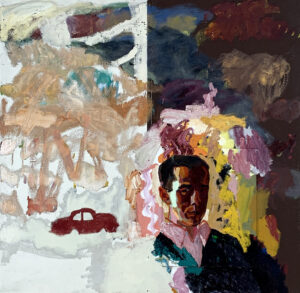
Philip Morsberger has been a painter for more than fifty years. Moving between the USA and Britain at regular intervals, he has witnessed all the major developments that have taken place in art during those years. Yet through it all he has maintained his own distinctive outlook on the world, which has, in turn, found expression in a highly personal style of painting. Although obviously conversant with the different art movements that have come and gone during his own lifetime, Morsberger has not allowed himself to be categorized, just as he has never associated himself wholeheartedly, or for any length of time, with one particularly influential artist or group of artists.
What Morsberger does have is a strong commitment to the principles that underlie his art. Those principles will become apparent in the course of this book. Equally apparent is the fact that those principles have been present from the outset and that, regardless of the variety in his paintings, Morsberger has never deviated in his pursuit of them. Allied to this is the artist’s compulsive work ethic and iron self-discipline. Wherever he has been in the USA or Britain, the studio has been the hub of all his activities. He does not carry a sketchbook, and he eschews photography. Instead, he engages directly with people and then relies on visual memory. Such an approach derives in part from Morsberger’s initial training, but it also has to do with the way he has evolved as an artist. The studio is very much a private space, used not only for the concentrated activity of making art but also for solitary musing, reading, and reflection. His inspiration comes from inside himself, as opposed to external influences. For example, Morsberger loves music in all its forms, but he never listens to it while painting, as it is a distraction. Similarly, the eating of a carefully prepared sandwich lunch is a ritual accompanied by reading — Charles Dickens, Henry James, Arthur Conan Doyle, John Steinbeck, Anthony Burgess, Paul Auster, Peter Carey, or Joyce Carol Oates.
The various studios Morsberger has occupied are invariably converted spaces that are quickly transformed in ways that hint at the monastic cell. Apart from the essential materials for painting, there is a large selection of books, a random group of photographs and postcards of works of art by admired artists (El Greco, Paul Gauguin, Vincent Van Gogh, Henri de Toulouse-Lautrec), a few personal mementoes, and two pianos — one an upright and the other a miniature — both of which are played. The appearance is spartan and hermetic. It is a private world, but one that is not totally disengaged from reality so much as a comment on it. Correspondingly, the visual language of this private world is articulated in a highly personal iconography based on the artist’s own experiences.
There are few self-portraits in Morsberger’s oeuvre, although his features occur quite regularly in several of his more recent compositions. Neither is the role of the artist one that he has chosen to explore in his art. Even so, certain pictures are in essence allegories of painting: The Artist’s Dream, Cosmic Scribbler, Turtle and Friends, and Dog Day Afternoon. Two of these — The Artist’s Dream and Cosmic Scribbler — refer directly to the art of drawing. In Turtle and Friends the artist is depicted in the lower right corner as a turtle, and in Dog Day Afternoon he is more grandly represented in the right half as a dog sporting a pair of knickerbockers. Only in this last picture is the figure shown actually confronting a canvas. Anthropomorphic representations of this kind may suggest a playful attitude to the art of painting, but such a deduction would be wrong, and it is typical of Morsberger that he goes to these lengths to conceal the truth about what he feels. Consequently, the allusion to the artist in Hail the Conquering Hero is meant ironically.
In his mature paintings Morsberger conjures up his own mythical universe, comprising a whole cast of fantastical creatures, both human and animal. The effect is like a medieval bestiary. The animals are mostly benign and friendly, as though domesticated, and indeed it is no surprise to discover that the artist actually kept turtles as pets when a child. The humans are wide-eyed, with simplified features, leering expressions, elongated, almost disjointed, limbs, large feet with heavy boots, and pudgy hands with banana-shaped fingers. These figures are rarely still and often shown running. One writer has aptly suggested that it is always rush hour in Morsberger’s paintings.
All these creatures inhabit a turbulent, chaotic world that is hugely energized and dominated by a mood of restlessness. Everything is speeded up, as if permanently set at fast-forward, and this imparts a feeling of disjunction or even displacement. Bodies seem to float as though in a chemical experiment or as in space, often colliding before moving off in different directions. It is a prelapsarian world in free-fall — or so it would seem at first sight.
These same paintings also allow for some general observations to be made about Morsberger as an artist. Although the subject-matter is couched in highly personal terms, it has a universal application. Much of the imagery and several of the recurring motifs relate to the history of the artist’s own times. The random accumulation of symbols is frequently unified by an overall narrative that is succinctly explained by an apt title. Only during the 1960s is the subject matter overtly political, but that is in itself hardly surprising, given the dramatic history of the USA during that decade. Religion, too, is a subject that is rarely confronted straight on in Morsberger’s work, even though it is possible to argue in the broadest terms that religious principles have been an underlying factor from the start and have become more sharply defined by his conversion to Roman Catholicism in 1976.
Technical aspects are also a vital consideration. What may look like a naïve — or even faux naif style — is in fact carefully honed, being based on a firm scaffold of academic drawing and a diligently researched understanding of color. Indeed, the nurturing of orthodoxy both within himself and in others has given Morsberger the flexibility to paint in a variety of styles. Versatility and irrepressibility are two of his most obvious personal characteristics, and they are dearly evident in his art. It is the same with his playful sense of humor, which is based on a childlike innocence. However, the dividing line between despair and hope in Morsberger’s paintings is a fine one, and it is not always clear-cut. Within many of the paintings there are pertinent, even if oblique, observations on personal relationships and the state of the world — and in the artist’s mind these overlap. The predominant mood, however, is never one of total despair, or even the temptation to give in to despair. The reality is quite the opposite, since Morsberger’s purpose is to paint a commentary on la comédie humaine. His world is essentially one of optimism born of incredulity.
Family Life
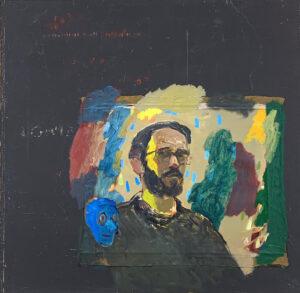
Philip Morsberger was born in Baltimore, Maryland, on March 17, 1933, the second son of Eustis and Mary Burgess Morsberger. His father was a printer by training, but after attending Johns Hopkins University, where he read English Literature, he became a proofreader on The Baltimore Sun from 1923 until 1939, with special responsibilities for the famous column written by H.L. Mencken — perhaps the most distinguished American journalist of his time. Subsequently, until his retirement in 1964, Eustis Morsberger served as Special Assistant to the Public Printer at the Government Printing Office in Washington, DC. The Public Printer was a political appointment, but the Special Assistant straddled administrations and had the status of a civil servant who dealt with any aspect of central government policy pertaining to the official printed record. While her husband commuted daily to the capital, Mary Burgess Morsberger taught English and French at local schools and during the vacations worked as a private tutor. Her vocation as a teacher enabled her to play a positive role in supporting her children when they began to develop their own special interests. Mary, however, had a quieter personality than her husband. It was Eustis Morsberger (but not Mary) who attended the local Protestant Episcopalian church of St. Bartholomew in Baltimore, where he also taught in the Sunday school. Religion, though, was not a pervasive matter in the family household. In fact, it is more accurate to say that an atmosphere of anarchic humor prevailed at home.
A great deal of Philip Morsberger’s art is grounded in his family. His maternal grandfather, for example, was a stationer who introduced him to a whole range of printed and illustrated material, including calendars evoking Norman Rockwell’s homespun themes. More significantly, it was this grandfather who, on one of his regular visits, showed him how by drawing lines over a printed image you could completely alter its meaning. This demonstration of the transformative effect of art was a true revelation, and Morsberger identifies this as the specific impulse that made him want to become an artist. What at first seemed to be an image fixed forever could suddenly be transmuted by sleight of hand into another with an entirely different meaning. Such a simple act also hinted at the innate power that an artist could have in the wider world.
Other everyday aspects of the Morsberger household were formative. Eustis retained his skills as a printer. His press was kept in the basement, where he set his own type, designed illustrated leaflets, and printed material for St. Bartholomew’s Church. He also had a passion for comic strips, which were — and still are — a staple diet of American newspapers. Little Orphan Annie, by Harold Gray, and Dick Tracy, by Chester Gould, were pored over daily by the entire family and enjoyed for their vivid characterization, ingenious storylines, and wide-ranging artistic creativity.
Films, too, were important, and such performances as Charles Laughton’s Quasimodo in The Hunchback of Notre Dame (1939) were relished to the point of imitation. The artist still regards many of the films he saw during his childhood as major influences. Gunga Din (1939) was a particular favorite, while performances by such stars as Ronald Colman, Errol Flynn, and Merle Oberon remain in his mind.

Most of all, Eustis Morsberger is remembered both within and beyond the family for his sense of humor, which veered from the whimsical and eccentric to the mordant. Guests were often bemused by the fact that formal grace before a meal amounted to a critique of the food laid before them. In other ways a traditionalist, he had an extensive collection of hats, which can be identified in his son’s paintings.
An elder brother also formed part of this strong family ensemble. Robert Morsberger was born in 1929. He taught Philip to play the piano by ear, as well as inculcating the basic elements of drawing by illustrating incidents from his favorite adventure stories and the exploits of his heroes. Robert was an avid reader of a comic strip entitled “Tailspin Tommy,” which he seems to have acted out in a small tricycle airplane that he preferred to more traditional forms of transport. Robert Morsberger, however, favored literature over art or music and so embarked on a distinguished career as an academic and writer. Although a respected authority on James Thurber, John Steinbeck, and Lew Wallace (the author of Ben Hur), he has also written on film and theater.
These family ties were significant not only in the formative sense, since they recur in Morsberger’s art at a later date. A Long Day’s Journey is strictly autobiographical. It shows Eustis Morsberger on his bicycle, bizarrely placed in an interior, with his wife on the left and his two sons under the arch in the right background. Inspired, as the title suggests, by Eugene O’Neill’s play, which the artist saw in the film version of 1962, the painting is intended as a response to the tensions that overwhelm the household, presided over by the tyrannical James Tyrone. This work is an isolated example of a strictly autobiographical painting done while Morsberger’s parents were still alive. However, during the 1980s, after the death of his father in 1975 and as his mother’s life was drawing to a close in 1984, Morsberger returned to the theme and embarked on a number of canvases painted in a narrative style inspired by the comic strips that he admired. Not only is the deliberate use of this style a clear reference to his childhood, but so too is the imagery. Eustis appears constantly, usually with one of his hats, which the artist sometimes uses as a symbol of death, suggesting the literal expunging of life like a candle snuffer. Mary Burgess Morsberger does not appear so often, although on occasions her features are concealed or enveloped by other figures surrounding her and emerge only after careful examination. Robert is always the pilot, equipped with helmet and goggles buzzing about in the airplane. These canvases have such titles as Remembrances, Remembrance of Things Past, Family Group, Fathers and Sons No.2 (The Red Shoes), Ghosts No.2, and Blithe Spirits No.1. Yet other paintings of similar date are more obviously autobiographical — First Steps, Reaching the Top, or Knickerbocker Holiday No. 2 — while The Hunting Ridge Follies and Evolution of a House Painter both contain references to Baltimore.
Although started in the 1980s and continued in the 1990s, Morsberger is here still haunted by this family imagery. Family members remain in his mind as “presences” brought back to life on the canvas. These paintings adumbrate universal truths about life and death through a sequence of personal references. They remain anchored in a distant, almost mythical, past, even though the act of painting them is an assertion of independence. Only the airplane, piloted as ever by Robert Morsberger, introduces a more modern note, both literally and metaphorically, by symbolizing the rite of passage that both brothers undertook as part of growing up and leaving the family home in Baltimore to go their separate ways.
Becoming an Artist
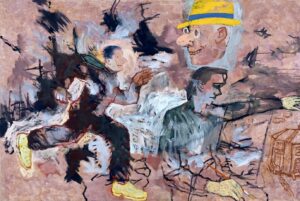
Philip Morsberger’s rite of passage began with his attendance at schools and colleges in Baltimore. His proclivity for art had emerged early on and was acknowledged while he was at Gwynns Falls Park Junior High School, when in June 1946 he was recommended for a summer scholarship at the Maryland Institute College of Art, being described as “a very young but very talented artist” with an ability “to draw anything and everything” that is “far above the average.” Evidence of this is the rare survival of a comic strip which he drew soon thereafter for his high school.
The previous summer he had been recommended for a similar type of scholarship in music to the Peabody Conservatory of Music, indicating that his talent could have taken him in another direction. Music remains a passion, with a frequently performed and extensive repertoire on the piano, but a declaration in favor of art was followed after high school by three years initial study (1950-53) at the Carnegie Institute of Technology (now Carnegie Mellon University) in Pittsburgh, Pennsylvania. There he studied with Balcombe Greene, Samuel Rosenberg, and Robert Lepper, who had taught Andy Warhol. Other distinguished artists to have emerged from the Carnegie University are Philip Pearlstein and, more recently, John Currin — both figurative painters.
The Carnegie Institute of Technology exposed Morsberger to different aspects of art. The dominant style of those years was Abstract Expressionism, to which Morsberger did not personally respond at this early stage in his development. His preference was for narrative painting, and among his sources of inspiration were the figurative painters based in the Bay Area of San Francisco. He was by instinct an artist who put drawing first, and he found that he had arrived at the Carnegie Institute of Technology just at the moment when it was moving away from the traditional precepts of teaching that had originated in the nineteenth century. Sensing change, the Carnegie Institute of Technology stressed innovation, putting greater emphasis on independence of mind and action than on the more formal, structured approach usually promulgated in art schools. To a certain extent, therefore, Morsberger saw himself as contra mundum. Study of a Female Head (“The Egyptian”) is an example of his resistance to the emphasis on non representational painting and demonstrates his concern for a considered, close-up analysis of the model, as opposed to an impulsive response. Detailed observation was what he sought, in opposition to an immediate reaction masquerading as modernity. Nonetheless, some of the new ideas to which he was exposed at the Carnegie Institute of Technology were stored up for use at a later stage of his development. Little did the artist realize the extent to which in future years his life would become inextricably linked with art schools both in the USA and Europe; little did he anticipate that the Carnegie Institute of Technology would be a rehearsal for future battles.
Morsberger’s time at the Carnegie Institute of Technology was interrupted by his draft in to the army in 1953, during the Korean War. He served first in the 503rd Military Police Battalion at Fort Bragg in North Carolina and then was miraculously transferred to the Signal Corps at the Supreme Headquarters Allied Powers Europe (SHAPE) in Paris rather than being shipped off to Korea. This was his introduction to Europe. Those serving in the Signal Corps turned out to be sympathetic and convivial men, and, as it happened, many were involved in such projects as filmmaking — one of the artist’s greatest interests. Morsberger was able to explore Paris and attend night classes at the École de la Grande Chaumière. He also traveled in Italy. After being discharged he returned to the Carnegie Institute of Technology for his final year before graduating as a Bachelor of Fine Arts in 1956. This accolade coincided with his marriage to Mary Ann Gallien from Fairmont, West Virginia, with whom he was in due course to have two children: Wendy (born in Oxford, England, in 1957) and Robert (born in Oxford, Ohio, in 1959).
Both the teaching at the Carnegie Institute of Technology and the introduction to Europe helped Morsberger in his development as an artist. Such opportunities enabled him to define more closely what kind of artist he aspired to be. Furthermore, they hardened his resolve to progress in a particular direction.
One of the most enlightened pieces of legislation in American history was passed into law in 1944. The Serviceman’s Readjustment Act (better known as the GI Bill of Rights) anticipated the problem of rehabilitating thousands of veterans into civilian life after World War II at a time when American society was rapidly changing. Availability of jobs and benefits were addressed in the act, but, more importantly, provision was made for veterans to complete or embark on their education at the government’s expense. Whole sections of the community were thus presented with an opportunity never before given to them.
Morsberger was himself eligible for support from the Bill of Rights, and he saw that this would be one way of continuing his training as an artist. The Bill allowed for foreign placements, and, although Paris had been officially excluded because of its many distractions, attendance at art schools in Britain was encouraged. The choice was either the college of art in Edinburgh or the Ruskin School of Drawing at Oxford, England. The prospectus for the Ruskin School offered the kind of tuition that the Carnegie Institute of Technology had moved away from, and so, having applied to Oxford and submitted his portfolio, Morsberger was accepted for admission in the fall of 1956. This is the year that marks the start of his long association with Oxford and its university.
Oxford (England)
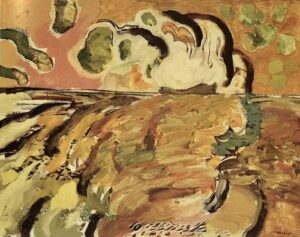
The Ruskin School of Drawing was founded in 1871 with funds bequeathed by a wealthy lawyer, Felix Slade, whose purpose was to establish professorships in the fine arts not only at Oxford but also at Cambridge and London universities. Oxford appointed one of the great cultural figures in nineteenth-century Britain as the first holder of the chair. John Ruskin can be narrowly defined as an art theorist and social reformer, but his range of interests was far wider. He inherited wealth and was a collector, particularly of watercolors by J.M.W. Turner, whom he befriended and championed in his writings. In addition, he was himself a superb draftsman and watercolorist and a charismatic lecturer, and he wrote mesmerizing prose. On the other hand, Ruskin tended to overwork, and his personal relationships were never straightforward. Consequently, he suffered nervous breakdowns and periods of mental stress.
The idea of a school of drawing at Oxford was first advanced in Ruskin’s inaugural lecture on February 8, 1871. The school was to be located in the University Galleries (later the Ashmolean Museum) in Beaumont Street, and the first Director of the Ruskin School was Alexander Macdonald, who held the post for fifty years until his retirement in 1921. At first, however, the presiding genius was, of course, the eponymous founder. Ruskin’s generosity — both in time and in kind — was inspirational, even though in the end his time as Slade Professor was interrupted by illness, which forced his final resignation in 1885. Not only did he endow the post of Director (later to be called Master), but he also presented his personal collection of 800 or so drawings, watercolors, prints, and photographs, which included a number of watercolors by Turner. These items were originally intended for teaching purposes; they all remain in the Ashmolean Museum. After Macdonald’s retirement the position of Master was held by Sydney Carline until 1925, and then by Albert Rutherston (né Rothenstein) until 1945.
Morsberger’s arrival as a student in Oxford coincided with Percy Horton’s term of office. Horton (1897–1970) had trained first at Brighton School of Art and then at the Central School of Arts and Crafts in London before progressing to the Royal College. He spent much of his life in art education and served as Ruskin Master in Oxford from 1945 until 1964, His art, especially his portraiture, shows an innate sympathy for people from all walks of life, observing them with an intensity and objectivity worthy of Paul Cezanne, by whom he was influenced.
The Ruskin School in Oxford emphasized those aspects of art training that were beginning to disappear from art schools in the U.S.A. Horton taught according to the strictest academic precepts. Able students were expected to be proficient in making works of art from life. Since the Ruskin School was located in the Ashmolean Museum there was plenty of opportunity initially for copying from works of art, particularly antique sculpture. Once this skill had been attained there began the long process of drawing and painting from the live model. The supply of models was plentiful, and the same model was often hired for several weeks on end. Visitors to the Ashmolean Museum would have been aware of the Ruskin School students. They were to be seen intermingling with the works of art seated on small benches (known affectionately as “donkeys”), gripping drawing boards and staring intently straight ahead of them.
The American writer John Updike spent a formative year as a student at the Ruskin School in 1954–55, with a scholarship from Harvard University. In his short story “Still Life,” first published in 1958, Updike refers to the relationship between the Ashmolean Museum and the students from the Ruskin School as “perhaps less motherly than absent-mindedly inclusive.” Horton is identifiable in the story as Professor Seabright. His teaching methods are described, and he is referred to, perhaps unfairly, as having a “musty aesthetic” and as inhabiting “a tender, subdued world founded on violet.” Updike later made amends by making Horton one of the dedicatees of his book Just Looking (1989). More recently, Updike recalled in a letter “the student body as one third young English males bent on becoming artists, a third English females whose vocations were more free-form, and a third American GIs anxious to become abstract expressionists and getting little encouragement from Percy Horton.” Neither Updike nor Morsberger had any intention of becoming an Abstract Expressionist, and they were therefore exceptions. Even half a century later Updike remembers the smell of turpentine rising as “a Paradisiacal aroma.”
A fair proportion of Morsberger’ s work done while at the Ruskin School is preserved today. A group of academic studies drawn from posed models is exactly what is to be expected of work undertaken at an early stage of any artist’s development. Carefully, sometimes awkwardly, posed figures are tentatively drawn. Often the proportions or the scale goes awry; the line falters, or the hatching wanders off in the wrong direction. Yet, equally, there are moments when everything gels and the line sings. This type of drawing is about the setting of personal standards in the long search for perfection. There is also a nervous tension about the oil sketches done from posed models. Ivy Cavendish is ambitious in its tenebrous lighting in the manner of a Mary Magdalene by Georges de la Tour, but the attempt is to be admired. And even Horton might have praised “The Englishman” for its accurate observation and pleasing tonal qualities.
The discipline acquired while at the Ruskin School has remained with Morsberger throughout his working life. Not only has he stressed its importance to those he has taught or encouraged, but in doing so he has never exempted himself from continuing the practice of drawing or painting from the model. A number of other Americans took advantage of the GI Bill of Rights to be in Oxford: the painters Elemore Morgan, R.B. Kitaj, and Neil Shevlin attended the Ruskin School, while the sculptor William Tucker, who was at Brasenose College reading Modern History, also took advantage of the facilities. Reminiscences by Kitaj and Tucker are printed elsewhere in this book in the section of Appreciations.
One of the traditional advantages of the Ruskin School was that its reputation attracted several part-time teachers from London, invited by the Master. It was in this way that Morsberger came across artists of the caliber of Rodrigo Moynihan, John Piper, Colin Hayes, Anthony Fry, Mary Fedden, and Laurence Toynbee. Similarly, being so close to London meant that access to major museums and galleries was not difficult. Morsberger particularly sought out works by Stanley Spencer and Francis Bacon. Of the better-known commercial ventures there was the Beaux-Arts Gallery, where works by the young John Bratby were shown. Bratby’s paintings impressed Morsberger, and an influence can be seen in his rare still lifes, but particularly striking to Morsberger were the paintings that Bratby did for the film set of The Horse’s Mouth (1958), about an artist called Gulley Jimson. Alec Guinness wrote the screenplay and acted the part of Gulley Jimson, an artist determined to make his mark on the world by any means. The film remains one of Morsberger’s favorites, along with the novel of 1944 by Oxford’s Joyce Cary on which Guinness based his screenplay.
Oxford (Ohio)
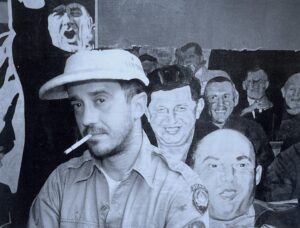
After the Ruskin School Morsberger returned to the U.S.A., where he was appointed to the art faculty of Miami University at Oxford, Ohio — thus exchanging one Oxford for another. Morsberger taught at Miami University for nearly ten years and was occupied in a number of activities beyond teaching. He hosted a series of television programs entitled Dialogues in Art; he acted (notably as a convincing King of Siam in The King and I); and he had a close involvement with the Miami University Hiestand Gallery both as a contributor and as an administrator. But, however significant those activities may have been, it was Morsberger’s art that was his main concern.
The 1960s in the USA began in a mood of optimism. The Inaugural Address of President John Kennedy given on January 20, 1961, underlined the aspirations of a younger, more vital America. Disillusionment, however, soon began to lap at the door of a White House that had been compared with King Arthur’s court at Camelot. Years later, the war in Vietnam and the campaign for civil rights were compounded by a series of assassinations (President Kennedy, Dr. Martin Luther King, Malcolm X, Robert Kennedy), widespread civil unrest, and often violent demonstrations in the streets and on university campuses. Morsberger engaged with these issues. The close attention he had paid to his training was now to bring dividends in an art that in a remarkably articulate and direct way both charted and expressed outrage at social injustice. His paintings provide a vivid record of a turbulent time in recent American history, and they are in effect exercises in political and social realism. It is unlikely that he expected his work ever to embrace this degree of immediate relevance, but it was his sense of social justice, his abhorrence of violence, and his personal courage, combined with the awakening and harnessing of his skills as an artist, that enabled him to portray so openly these dramatic events as a form of reportage. The paintings and drawings dating from his years at Miami University form part of a collective memory: namely, the exercising of public conscience.
President Kennedy was assassinated in Dallas on November 22, 1963. Morsberger’s instinctive reaction was to start a painting, and he began to depict the scene as he imagined it from the initial reports. Only later on, after seeing the stills from the amateur film made by Abraham Zapruder published in Life magazine, did he realize that his own interpretation of the scene was inaccurate. Beginning again, the composition assumed a narrative form by following the vertical frames of the film strip itself. The jerky sequence of Morsberger’s painting not only captures the drama of the occasion but also uncannily anticipates some of the questions that would be asked about the number and direction of the bullets. Indeed, Zapruder’s film was an important piece of evidence in the subsequent official inquiries. The death of President Kennedy is a subject remembered mainly through photographic or electronic images. Morsberger, however, here asserts the primacy of painting as a proper visual record of a major historical event, and he was to continue this practice for the rest of the 1960s.
Missing (Nos. 1, 2, and 3) and Hey, Let’s Have Some Red Man! (The Arraignment) were undertaken while different, but no less consequential, events unfolded in 1964–65. The focus of attention in these works is the civil rights movement in the light of the Civil Rights Bill, which was passed into law during the summer of 1964. In that same year at Oxford, Ohio, a conference was convened (June 14–29) on the campus of Western College for Women for the training of young activists (mostly from universities) who had volunteered for work in the state of Mississippi, which was then still dominated by a white supremacist society. The project, known as “Freedom Summer,” was an exercise in interracial cooperation intended to spotlight areas of continuing racial hatred. The volunteers were trained in all aspects of social integration, including teaching and such exercises in citizenship as voter registration. Potentially, it was extremely dangerous work, not least because of the active resistance to such programs by members of the Ku Klux Klan, who were entrenched in such southern states as Mississippi.
Three of those attending the “Freedom Summer” project were Michael Schwerner, James Chaney, and Andrew Goodman. Schwerner and his wife had already been active in Mississippi, where they had met, and they recruited Chaney. They in turn met Goodman at the conference at Oxford, Ohio. The three men set out for the town of Meridian in Lauderdale County of Mississippi on Saturday June 20 and went missing over the weekend. Eventually it became clear that they had been murdered on the side of a road south of the nearby town of Philadelphia in Neshoba County on Sunday June 21st. The bodies were disposed of at a dam site on a nearby farm and were recovered only on August 3. It emerged that the murders had been committed while the young men were in police custody and evidently with the complicity of the authorities, notably sheriff Lawrence Rainey and his deputy, Cecil Price.
The trial of eighteen defendants took place three years later, in October 1967. All the defendants were allegedly members of the Ku Klux Klan. They were accused not of murder but of “conspiring to violate the civil rights” of the victims after they had been arrested for a supposed motoring offense. Of the defendants seven were found guilty and given token sentences. A vivid account of this tragic event is provided in a short book by William Bradford Huie, Three Lives for Mississippi (1965, reissued 1968 and reprinted in 2000) — a book that takes its place alongside Truman Capote’s In Cold Blood and Norman Mailer’s The Executioner’s Song. The murders in Mississippi are still discussed today.
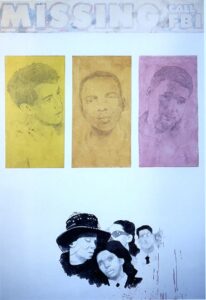
Morsberger began Missing No.1 before the bodies of Schwerner, Chaney, and Goodman were found and based his image on the official poster issued by the Federal Bureau of Investigation. On hearing that the men had died, the artist, in despair, painted out the composition but then scraped the canvas to make it seem as though their photographic portraits were emerging like ghosts, thereby creating a visual metaphor for their predicament. Missing No. 2 was drawn in memoriam immediately afterward, but it is a subject of continuing interest that still haunts Morsberger today: Missing No. 3 dates from 2002–03 (left).
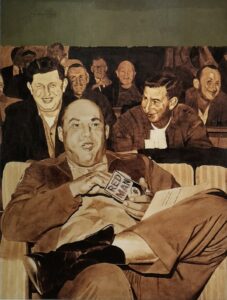
The composition of Missing is understated, whereas Hey, Let’s Have Some Red Man! (The Arraignment) is confrontational (right). Essentially, it is a study in evil, commemorating a cynical and premeditated act of violence. These are the murderers of Schwerner, Chaney, and Goodman at a preliminary court hearing. The starting point for the composition was a photograph in Life magazine. The bold foreshortening, the strong highlighting, and the leering faces — of the sheriff and his henchmen — create a sinister and frightening impression. These are portraits of people who regard themselves as above the law, untouchable and lacking any sense of contrition. They scoff and laugh. An identifying inscription along the top of the picture was later removed by the artist as redundant. As with Missing, the summation comes with the drawing done after the painting almost a final exorcism. Exaggeration of the main figure’s characteristics, alterations in the poses of the figures in the middle distance, and the completion of the background create a more caricatural impression worthy of Honoré Daumier. For his involvement with this notorious case Morsberger won the Dorsey Award for 1965 given by the Oxford chapter of the American Civil Liberties Union.
Mothers is another work that reflects Morsberger’s concerns about American society. Inspired by a photograph accompanying an article in Esquire magazine on the mothers of famous people, he appropriated the image for a mixed media drawing but added his own mother, placed prominently in the foreground. The personalities chosen by Esquire magazine were Andy Warhol, Bill Moyers, and Jonathan Winters. Each mother is shown holding a photograph of her son. The choice of technique is similar to Robert Rauschenberg, but it is really the compositional juxtaposition of the figures, who have no direct association with one another, that raises the question of alienation and memory. And in that respect, it is difficult to avoid comparison with Christian Boltanski.
A small group of canvases of this time pursue the theme of the family. As has been seen, A Long Day’s journey looks back in time, but Family Group No. 2, for which students served as the models, is a reflection on the fragility of personal relationships. The title is ironic insofar as the figures singularly fail to communicate and are posed as in a play by Samuel Beckett. From this situation there is only escapism, as in romantic cinema — Wuthering Heights No. 2 — which is based on a poster for the film made by William Wyler starring Laurence Olivier and Merle Oberon — or the future as represented by one’s own offspring. The Children’s Hour (below) was posed by the artist’s children — Robert on the left and Wendy on the right. Both pursued careers in the arts (Wendy in ballet — she is now a member of the Dance Faculty of the Boston Conservatory — and Robert in music — he is now a composer and performer in New York), but here they are seen from above separated by an easel. The paintings along the right edge of the canvas are works by the children themselves, as indeed is the picture on the easel. The image betokens a spirit of optimism as the 1960s draw to a close. Morsberger has studied those issues that divide the world — war, social inequality, violence, estrangement — but there is solace in art just as there is hope in youth.

Oxford (England) Again
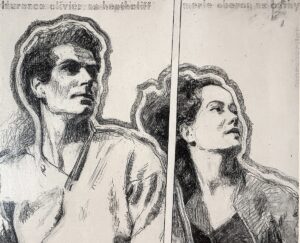
On leaving Miami University, Morsberger held appointments in upstate New York at the Rochester Institute of Technology (1968–70) and for a shorter time at Rosary Hill College (now Daeman College) in Buffalo (1970). He was then appointed Master of the Ruskin School of Drawing at Oxford, England. This was his next important challenge. Morsberger was Master from 1971 until 1984 and during those thirteen years elevated the status of the Ruskin School in Oxford life. He was the sixth Master in the school’s history and the first American to be appointed to that position. Having been a student at the Ruskin School himself during the 1950s, Morsberger was aware of the institution’s strengths and weaknesses. Even though it was somewhat against the spirit of the times, he was determined to uphold the primacy of drawing as the basis of art, but what also concerned him was the lack of recognition that the Ruskin School had within the university. Its reputation was greater outside Oxford than amid the dreaming spires. The reversal of this situation became Morsberger’s mission in Oxford, and soon after his arrival he initiated a policy of Ruskin School resurgens. History showed that as early as 1875 it had been mooted that the Ruskin School should award degrees, but there was no progress in this matter for a hundred years. At the time of Morsberger’s appointment the future of the school was even in some doubt. The Vice-Chancellor, the historian Alan (later Lord) Bullock, questioned the role that such an institution might play in the future of the university. Subsequently Bullock wrote that it was Morsberger who convinced him of the need for an art school as part of a broadly based educational system and also of its greater efficacy if it was empowered to award a degree comparable with other faculties. Bullock decided, in short, not to close the Ruskin School but to integrate it more closely into the university. Accordingly, committees were formed to examine and report on the Ruskin School in 1972 and 1976. On neither occasion was the school found wanting, but the idea of an undergraduate degree in Fine Art had to have the support of the governing body of the university, known as Congregation. Oxford in the past had often resisted changes to its academic syllabus, but the debate held on March 8, 1977, ended with a majority in favor of having a studio degree in Fine Art (BFA) after three years (officially in Latin a Baccalaureus in Bellis Artibus). It was a historic moment and one with considerable consequences. The Ruskin School moved out of its quarters in the Ashmolean Museum and was relocated in a nineteenth-century building known as the Examination Schools, in the High Street. This ensured its independence. Students, who were admitted from October 1978, were affiliated with individual colleges and thus were properly integrated into university life. The course itself concentrated on the practical — drawing, painting, printmaking, sculpture — but also had a theoretical component that had not been so prominent before — history of art and anatomy. Examinations were taken at the end of the first year and in the final year.
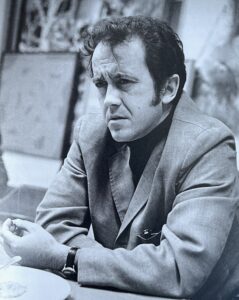
A great deal of Morsberger’ s time at Oxford was taken up with campaigning and lobbying for this change in the Ruskin School’s status. He himself as Master was elected to a Fellowship at St. Edmund Hall, a college founded in the thirteenth century, on the other side of the High Street. During his years as Master, Morsberger had two periods of leave: one (1976) was spent as a Fellow of the Carpenter Center for Visual Arts at Harvard University and the other as Artist in Residence (1983) at Dartmouth College at Hanover, New Hampshire.
The evolution of Morsberger’s own work took a rather surprising turn during his second period in Oxford. This was partly as a reaction against the 1960s in his determination to escape from what he described as “a bellyful of all that tragedy, ugliness and unhappiness.” While he was fulfilling his obligations at the Ruskin School, his own paintings were moving toward an abstract style that was more concerned with color than with drawing. The experiences of the 1960s and the engagement in university politics led to the artist internalizing his emotions and thoughts, which now began to find an outlet in non-representational compositions diametrically opposed to the realistic paintings that had been done at Miami University. Significantly, Morsberger refers to these abstract paintings as “mindscapes” or “inscapes.” The latter term is one associated with the nineteenth-century poet Gerard Manley Hopkins, who was a student at Oxford University, where he had been influenced by Ruskin. “Inscape” was intended to denote the unique quality of everything in nature. Hopkins’s poetry is intense and often original in its use of language, by which it is invested with an obscurity and density that are not unlike some forms of abstract painting. A further connection between the poet and Morsberger lies in Roman Catholicism. Hopkins was received into the Catholic Church by Cardinal Newman in Oxford in the late 1860s, and it was while he was in Oxford that Morsberger himself began to consider becoming a Catholic. His own conversion occurred in the mid-1970s, and he was accepted into the Catholic Church while at Harvard University in 1976.
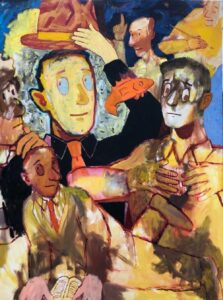
The move toward introspection is apparent in The White Background, a powerful self portrait painted in 1972. This is notable for its strong, rich color and its vigorous brushstrokes. The frontal pose directly challenges the viewer. It is a portrait that repels by its starkness and yet invites intimacy. There is a rawness that suggests a baring of the soul. Other self-portraits of the early 1970s are given more specific contexts. For example, Self Portrait with Running Figures owes a great deal to Pop art in its schematic, simplified drawing and the use of montage (the portrait itself is superimposed), but the vibrant color juxtapositions are closer to Fauve art. Even more intriguing is the compositional affinity with Gauguin’s Self Portrait with Yellow Christ. The implication in Morsberger’s painting is that the artist is being pursued by personal demons. The heart on the trunk is inscribed “S.T.L.J.N.,” standing for “St. Theresa Loves Jesus of Nazareth.” The stylistic dichotomy apparent in Self Portrait with Running Figures is also a feature of The World of Mr. Kirby, which is slightly later in date but still in the idiom of Pop art. Mr. Kirby was the Morsberger family dog and is represented in the left half of the picture by an agglomeration of abstract strokes that could have been inspired by the late paintings of Titian. The placing of the portrait is cleverly done and is dependent on the differentiation of the tonal values of the background. The approach to abstraction was made through a group of small landscapes, several of which were inspired by the countryside of Cornwall, in the southwest of England. The group is a rare occurrence of the normally sedentary Morsberger being influenced by a particular place that he happened to visit. The paint in these pictures has been rhythmically applied with broad brushstrokes loaded with pure pigment. There is a controlled dynamism in these taut compositions, which use color and texture to suggest recession and atmosphere. Emil Nolde and David Bomberg come to mind, but in these pictures Morsberger is discovering the potency of paint as a substance and the variety of ways in which it could be applied to the support.
The transition to abstraction can be seen in two untitled landscapes of different formats, where individual rural motifs can be discerned but which in the broader context lose their specificity and so become part of a more open, fluid composition of dissolving shapes and forms. Sometimes these paintings seem to retain residual landscape motifs — distant hills or bosky glades — but increasingly they depend on color and the materiality of paint itself. Vibrancy of the surface is often their touchstone, derived from the fusion or overlapping of a whole range of brushstrokes. An outstanding work in this category is Lightburst, with its refulgence of various tones of yellow applied with a brush and fingers in thick impasto. The surface is deliciously buttery and slippery, with the paint forming separate rivulets like ski runs that send the eye shooting off in different directions. The three-dimensional aspect of the surface imbues the painting with a physical quality of its own that extends its visual possibilities. By contrast, “Yellow” is painted very thinly and has a far broader range of color than the tide suggests. It is a very loose, fissiparous composition, which the artist has tried to contain by the use of framing lines at the edges. The surface is agitated further by the addition of black charcoal strokes. Where Lightburst is still rooted in nature (particularly the tradition of British twentieth-century romantic landscape painting), “Yellow” looks upward and resembles a constellation in the sky. In such pictures Morsberger embraces abstraction.
While at Oxford as Ruskin Master, the artist pursued two other categories of painting: one was traditional and the other experimental. Portraiture had begun to absorb Morsberger’s attention while he was still at Miami University. Contemplative Man (Portrait of a Composer) is, in fact, an image of Winford Cummings, Professor of Music at Miami University. It combines good drawing with adventurous use of color in the freely brushed background. The figure is positioned in the lower right half of the picture. It is almost an Expressionist portrait, and in the play between the figure and the background Morsberger engages with the current preoccupations of the Bay Area painters in San Francisco. Portrait of Robert Goldsand: Pianist was also painted at Miami University but fits comfortably into the realist phase of the 1960s. The pianist is seated on a tall stool, with a table behind. He is seen slightly from below, so that the foreshortening and the serpentine curvature of the body encourage the eye to move upward to the triptych of images that show the sitter in additional poses. The use of the triptych form in order to impart more information in a portrait has an honorable tradition in European art, including the work of Anthony Van Dyck, Philippe de Champaigne, and Max Beckmann.
As Ruskin Master and Fellow of St. Edmund Hall, it was hardly surprising that Morsberger would be asked to paint an official portrait of the Principal of the college. Such portraits fill the dining halls and common rooms of every college in Oxford and Cambridge. The government research scientist Leuan Maddock was Principal from 1979 to 1982. A distinguished engineer and a Fellow of the Royal Society, Maddock is shown standing three-quarter-length in a window bay of the Principal’s Lodgings. The paint has been thinly applied on a rough absorbent canvas. The surface is dry and scumbled in parts. The composition is prismatic in its precision, with the figure secluded between the panes of glass and the patterning of the curtain. Clever use is made of the shadows cast by the framing bars of the window, which fall across the figure and help to unify the left and right sections of the picture. Clever, too, is the contrast between the panes of clear glass on one side and the patterned curtain on the other. The vertical axis is reinforced by the highlights on the face, the shirt, and the hands — all linked together by the tie. Some lines in The Prelude, by William Wordsworth, suit this portrait well.
Wordsworth was at Trinity College in Cambridge, where he could see from his rooms the statue of lsaac Newton by L.F. Roubiliac, and of this he wrote:
I could behold
The antechapel where the statue stood
Of Newton with his prism and silent face,
The marble index of a mind for ever
Voyaging through strange seas of thought, alone.
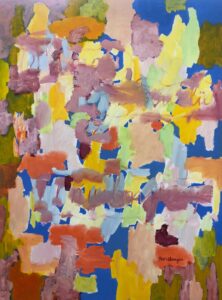
Another portrait of a head of house in Oxford was done several years later and is less formal. John Flemming, an outstanding economist and for many years Chief Adviser to the Governor of the Bank of England, was Warden of Wadham College from 1993 to 2003. As he was a longstanding friend of the artist, there is a greater sense of intimacy. The portrait was not the result of a sitting in the proper sense, but a combination of observation and memory. The concentration on the head, particularly the forehead, and the scale (virtually life-size) are comparable to Classical sculpture (or, in the context of Oxford, the famous heads of “Emperors” outside the Sheldonian Theatre), but it is the technique that captures the essence of the sitter, who is seen as though in conversation. The shape of the face emerges from the stark white background of the canvas and is then enfolded by shadows. Only the glasses are specifically drawn, as opposed to modeled. The effect is comparable to an overexposed photograph, so that the face seems somewhat ethereal, as though an apparition. The purpose of using this technique was to highlight the character of the sitter, whose intelligence and humor were always understated and whose manner was quiet, reflective, and softly spoken.
The experimental aspect of Morsberger’s personal output in Oxford is represented by a small group of aleatoric paintings. The composition was outlined on the support first. Eleven colors were laid out on the palette and numbered. It was the throw of a dice that then determined the color to be used. The simplified contours and powerfully annealed colors equate with Post-Impressionist art and then with Pop art, but the idea of producing images by chance was one that had been explored during the Renaissance by Leonardo da Vinci and Piero di Cosimo. Self Portrait with Running Figures anticipates this style, but two good examples are “Lookin’ Up” and In the Park. The statuesque figures and formulaic composition of In the Park look back to Georges Seurat and his progenitors, such as Puvis de Chavannes. Eleven paintings were made according to this system. For Morsberger they amount to an investigation of the true values of color as squeezed directly from the tube, as well as a return to narrative subjects, which he had eschewed during the 1970s.
Return to the USA: Resolution
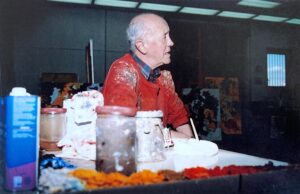
On his return to America from Oxford in 1984 Morsberger was appointed Visiting Artist at the College of St. Benedict in St. Joseph, Minnesota, and at the neighboring St. John’s University at Collegeville. Minnesota is a northern state that most people have been introduced to through the books and talks of Garrison Keillor, who began his broadcasting career at St. John’s University. Morsberger formed a close friendship at this time with J.F. Powers, who was awarded the National Book Award in 1963 for his novel Morte d’Urban. Powers was a fellow Catholic and explored in his work the fallibility of human beings, using a whole cast of characters practicing (for better or worse) the Catholic faith. His style and humor impinged strongly on Morsberger on a personal basis, and it is possible to assert that some of the artist’s late work is the visual equivalent of the novels and short stories of Powers. Author Jon Hassler, like Powers a writer in residence at St. John’s University, also became a friend and inspiration, as did Minnesota sculptor Joe O’Connell.
However, after two years the offer of a Chair in Art Practice at the University of California at Berkeley (1986-87) took Morsberger away from Minnesota, and a further appointment in California as President’s Fellow in Painting and Drawing at the California College of Arts and Crafts (1987-96) kept him on the West Coast. The kinship that he had felt several years earlier with Bay Area artists could now be indulged, and one of the pleasures of these years was his regular meetings with Elmer Bischoff, Richard Diebenkorn, David Park. They were all artists who throughout their lives tried to balance the equation between figurative and abstract art. This, in fact, is a quandary that has underwritten a great deal of Morsberger’s own work and came to a head after his return from Oxford to the USA. A decade in California was brought to a close when he accepted the position of William S. Morris Eminent Scholar in Art (Artist in Residence) at Augusta State University in Georgia; he became Emeritus in 2002. This geographical meandering has given Morsberger the time and space to refine his style in the light of his experiences in Britain and the USA.
There are two main strands in Morsberger’s mature work: the triumph of narrative expressed primarily in a comedic vein and the further exploration of abstraction. These, however, are not mutually exclusive styles, even if they may at first appear to be so. As has been seen, the comedic vein had always been present from his earliest years. Abstraction was resisted in favor of drawing to begin with but was embraced in the 1970s and returned to again in the 1990s. It may be true that in strictly numerical terms the narrative paintings dominate, but equal emphasis should be placed on the abstract paintings. To all intents and purposes, the distinction is in many respects a false one. In recent years, when starting a painting, Morsberger has no preconceptions as to how the composition will develop. The application of paint and its manipulation on the surface suggest forms to him that can either assume a human shape or simply remain non-figurative. There is no longer any distinction between drawing as preparation and painting as an act of completion. The artist has developed the ability to draw with paint as a single unified act. The end product arrives of its own accord: figurative paintings have abstract backgrounds, and conversely abstract paintings contain within them elements of human forms. This comes about as a result of the creative process often carried out on a single canvas over many years: the juxtapositions are not contrived, measured, or premeditated, and on occasions it is difficult for the artist to know when the picture is finished. In many respects Morsberger is reverting to those lessons that he was taught, but at the time rejected, while at the Carnegie Institute of Technology in the mid-1950s.
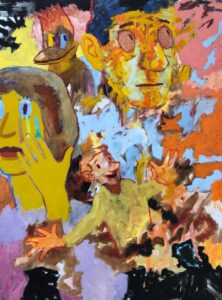
The return to comedic narrative in the early 1980s was really a reawakening of childhood interests. The comic strip tradition is omnipresent in the newspaper world of the USA, and, in addition, Morsberger himself collected the Big Little Book series, the titles of which were issued as an omnium gatherum of the more famous characters. Widely acknowledged as an archetypal art form, the comic strip has had some skillful practitioners who, like jazz musicians, have elevated the status of their art to a level of sophistication that made it a cross-over between high and low culture. Its chief characteristics were traditionally a compelling storyline and an economical, easily identifiable style that could bear endless repetition. The story was told in a series of strips containing individual panels that were arranged usually horizontally across the page. More creative artists were not restricted by any given format and could experiment with vertical and even diagonal layouts. Individual pictures were small, and they also had to contain a billboarded script. The visual balance between the image and the text was a vital element. Each panel had to stand out in its own right but was at the same time only one aspect of a more extended composition that comprised the whole page. The drawing of the figures and the setting had to be recognizable at a glance. Line, shading, and color, therefore, had to be applied almost stenographically, and so characterization was always exaggerated to the point of distortion. This type of drawing was a more expressive way of treating the human figure and when used by artists as diverse as Roy Lichtenstein or Philip Guston on a large scale could have tremendous visual impact.
Along with the visual inspiration that it offered, the comic strip also created its own world, inhabited by figures derived from the artist’s own imagination. Morsberger particularly relishes the world of Krazy Kat, devised by George Herriman, whose work has been compared to that of Miguel de Cervantes and Charles Dickens. Krazy Kat is essentially a love story involving a cat, a mouse, and a dog, acting as a policeman.
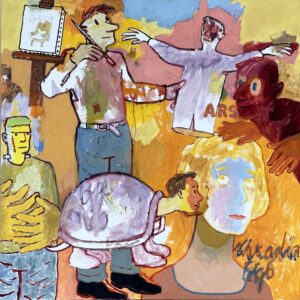
The storyline and its many permutations (often surprisingly violent) were pursued from 1916 until 1933. The strip’s combination of irony and fantasy tips over into Surrealism. The drawing is fine and delicate: it flows quickly and energetically to the point where the viewer is almost conscious of the flick of the artist’s wrist. The text is equally idiosyncratic. The characters tend to soliloquize and often resort to alliteration and onomatopoeia. Morsberger is attracted by the comic strip not only as an art form but also because of the humor it generates. Another favorite is about the fireman Smokey Stover, created by Bill Holman, which was popular during the 1940s and was specially adapted for publication in Britain, where it was admired by the young Brian Aldiss. Holman devised a whole world based on verbal and visual punning often exaggerated by phonetic spelling. Furthermore, within the narrative there were separate sections headed “Foomous People,” “Foomous Places,” and “Foolosophy.” Holman coined such words and phrases as “Swelterweight Champ” or “Soxafoon”; and he employed such expressions as “Winner by a Draw” and “Paint in the Neck.” One typical joke under the heading “Foolosophy” runs: “You can get along at Christmas time without puddings but you must have the dough;” another goes: “Private Stock Sez if all the Soldiers in Britain were laid end to end we wouldn’t have a standing army.”
Morsberger’s renewed exposure to the comic strip tradition was accompanied by memories of his family upbringing. It is for this reason that many of the images in his recent comedic narrative paintings are of a private nature, which therefore gives these compositions a ludic quality. As in the comic strips, Morsberger creates a whimsical world based on memory. The titles are often suggestive of the past and the artist’s desire to come to terms with his own personal anxieties. The resulting images are not terrifying, as they are in Hieronymus Bosch, or as playful as those of Joan Miro, or as cerebral as Paul Klee’s. Morsberger’s art is more like that of Marc Chagall in its ability to give his personal reflections a universal application. Humor now replaces the social realism of the 1960s, but that does not reduce its relevance or its pertinence. As the artist has said: “You have to laugh to keep from crying.” Color is a distinctive feature of the recent narrative paintings, but it is used to even greater effect in the pure abstracts dating from the 1990s onward, such as Le Rouge et le Noir, Metamorphosis, Ascension No. 2, Golden Days, Text/Subtext, or Lyric Etude. The white priming of these canvases enriches the explosive quality of the color and heightens its iridescent power. Morsberger now luxuriates in the warmth and richness of his colors: pink, yellow, green, gold, red, orange, brown, blue, purple, violet, and various mixtures of these. The colors sing on the canvas and in so doing reveal the artist’s admiration especially for Gauguin and Pierre Bonnard. There is a glorious climactic refulgence in these pictures that never tires the viewer or exhausts the artist.

The titles of some of the abstract compositions have religious overtones, and it is important to appreciate that Morsberger regards himself as essentially a religious painter. In the narrow sense there are two pictures directly inspired by scripture, both entitled Golgotha. The canvas painted in 1994-2002 is a deeply moving work in which Christ is suspended from the prominent horizontal bar of the cross with the Virgin Mary and St. John the Evangelist below on either side. The arms of Christ are almost vertical, as though being pulled out of their sockets, something emphasized by the narrowness of the canvas. The warmer colors used for the figures at the foot of the cross anchor them at the lower edge, while the light blue figure of Christ seen against a background of infinite space seems to soar upward. The delicacy of the palette is in stark contrast to the thick texture of the paint. The vertical bar of the cross behind Christ is omitted and is only suggested by a short section at the very top of the canvas. Because of this, Christ is both suspended and floating as if in the empyrean. Iconographically, this is the crucified Christ but also the resurrected Christ — Christus patiens and Christus triumphans in one image.
Such a picture is an open declaration of Morsberger’s personal faith, but he in fact regards all his paintings as a deep-seated commitment to a life-enhancing end. The social realist pictures of the 1960s were intended first as records of terrifying historical events, but secondly as warnings. Morsberger regards such undertakings as the duty an artist has to perform in society — to act as witness for future generations. The narrative paintings, which contain a considerable amount of Christian imagery in an understated way, are, in the artist’s own words “all about resurrection, about getting there — by airplane, or by foot, or with the aid of a magic cloak or whatever; and equally the abstractions are about moving upward out of the dark and into the light. They’re all about death and resurrection.” Seen in its entirety, Morsberger’s oeuvre could be seen as a personal interpretation of John Bunyan’s The Pilgrim’s Progress (1678).
One writer has referred to Morsberger’s pictures as prayers on canvas. The mood, however, is not necessarily reverential, and more often it is celebratory. Even now Morsberger feels compelled to paint every day. “I paint seven days a week. If I’m not painting life isn’t what it’s supposed to be.” There is also a close correlation between the act of painting and the act of worship. “When it’s going really well, one just feels like a conduit. This thing’s passing through you from wherever it comes and there’s a mystery about that. I’m just trying to make myself available to whatever it is.” Morsberger’s wife, Mary Ann, often asserts that all her husband “wants to do is paint and pray,” to which he replies, “They’re the same thing.”
